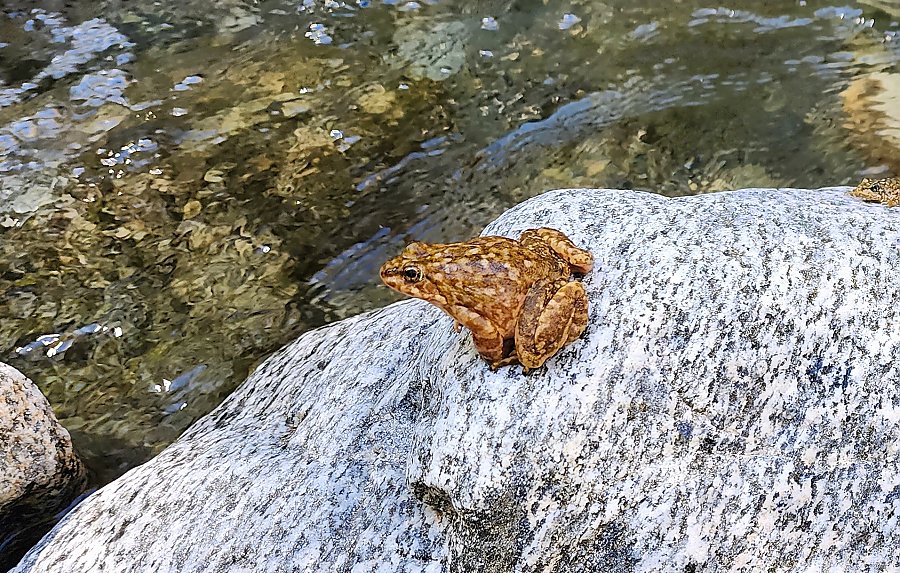
Ralphs
Discount tickets available at Ralphs for a limited time
Conservation program helps bolster wild population of critically endangered southern mountain yellow-legged frogs

Credit: Adam Backlin / U.S. Geological Survey
September 7, 2023
Approximately one hundred and seventy critically endangered southern mountain yellow-legged frogs were released into their wild habitat in the Southern California mountains on August 29 and 30, 2023. Most of the tadpoles were hatched at the Los Angeles Zoo and then traveled to the Aquarium of the Pacific and Santa Ana Zoo to be raised into frogs. Around ninety of the frogs were raised at the Aquarium of the Pacific and fifty were raised at the Santa Ana Zoo. The remaining frogs were from a group of tadpoles that were rescued from the Bobcat Fire that the Aquarium received in 2021.
“Releases of endangered species are exciting moments, but what makes this release extra special is that these frogs are from a genetically under-represented population, which can help to further increase the chances of this species’ survival,” said Brett Long, the Aquarium’s director of mammals and birds.
After the Bobcat Fire in 2020 threatened the cold-water streams where this species lives, government wildlife agencies rescued mountain yellow-legged frog tadpoles from these areas and placed them with local institutions like the Aquarium of the Pacific and other partner facilities such as the Los Angeles Zoo.
Since 2007, when the breeding colony was established at the Los Angeles Zoo, nearly 6,000 zoo-bred offspring have been released into the San Gabriel Mountains and surrounding habitats. This includes some tadpoles hatched at the Los Angeles Zoo and raised into frogs at the Aquarium of the Pacific and Santa Ana Zoo. The program is designed to bolster populations in the wild in an effort to save this species from extinction.
“This release is momentous for the L.A. Zoo as it marks another key milestone for our southern mountain yellow-legged frog breeding program,” said Ian Recchio, L.A. Zoo curator of reptiles and amphibians. “We are proud to be part of the continuing recovery effort with U.S. Geological Survey (USGS) and partners. We hope Angelenos will see this effort in their own backyard and think about actions they can take to help conserve wildlife.”
After this release, the Aquarium is continuing to care for more tadpoles behind the scenes to raise them from that vulnerable stage up to froglets for future release. The Santa Ana Zoo currently cares for forty-one juvenile frogs. Last year, 188 of these amphibians raised at the Aquarium and twenty-five from the Santa Ana Zoo were released to the wild.
Several organizations have partnered in the effort to raise and release the frogs. Scientists and officials from USGS and California Department of Fish and Wildlife monitor wild populations and oversee releases; and partners include institutions like the Los Angeles Zoo that breed and hatch frogs and like the Aquarium of the Pacific and Santa Ana Zoo that raise the tadpoles until they are ready to be released.
“It’s been an honor working with our recovery program partners to help ensure the survival of the mountain yellow-legged frog. They used to be one of the most common amphibians in our mountains, and we hope to see them thriving in their natural habitat again one day. Our goal is to establish at least twenty stable populations in the wild with at least fifty frogs each to ensure this species continues on for the next one hundred years. This recent release was one more step towards making that happen,” said Amber Suto, education specialist and key member of the Santa Ana Zoo’s recovery program.
Southern mountain yellow-legged frogs (Rana muscosa) are native to California’s mountainous regions and depend on habitats in the San Gabriel, San Bernardino, and San Jacinto Mountains. This species is a medium-sized amphibian, measuring between 1.5 to 3.25 inches on average. Adult frogs are a mix of brown and yellow coloring but can also be grey, red, or greenish brown, usually with dark spots or splotches. These spots can look like lichen or moss and make the frog appear camouflaged. The belly and underside of the back legs, and sometimes front legs, are yellow or light orange, which lends itself to the frog’s common name, “yellow-legged.” To help these frogs recover, you can support this conservation effort by staying on marked trails and paths, respecting signs announcing off-limits areas when visiting local mountains, and reducing your carbon footprint.
The public can view the southern mountain yellow-legged frog at the L.A. Zoo’s seasonal habitat inside its Living Amphibian, Invertebrate, and Reptile exhibit (LAIR). The habitat is open to the public during regular Zoo hours between May and November, after which the frogs move to the Zoo’s bio-secure amphibian breeding facility for the breeding season.

Discount tickets available at Ralphs for a limited time